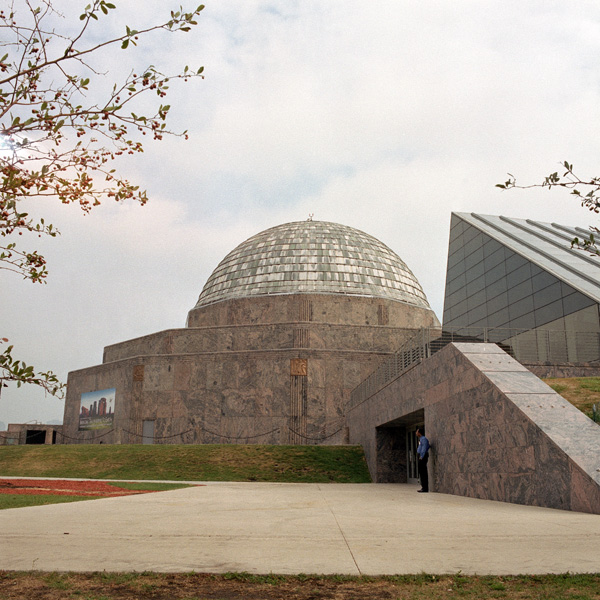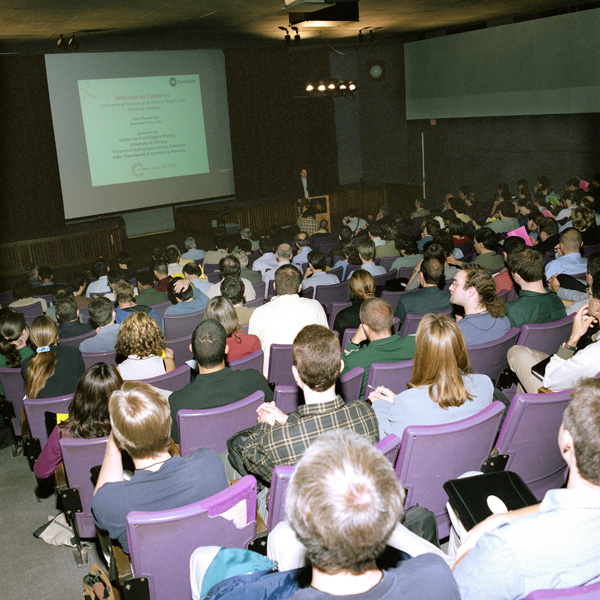|
Star Light Star Bright
Fermilab Public Affars intern Pamela Zerbinos attends the Cosmo-02, and discovers a field of dreams.
by Pamela Zerbinos
Wednesday, Sept. 18, 2002: Picture This
0730
I have always hoped that if the universe is to one day cease its outward
expansion and collapse back in on itself, that this will happen sooner
rather than later. It will put me out of the misery of wondering about its
expansion ó where is it going? This question makes my head hurt, and
I have always avoided cosmology because of it.
So the last place I ever expected to find myself is crammed onto a
Chicago Transit Authority ďL Ēcar, headed to Cosmo-02,the annual
International Workshop on Particle Physics and the Early Universe,
at the Adler Planetarium. The conference is being sponsored in part
by Fermilabís Theoretical Astrophysics Group, along with Adler and the
University of Chicagoís Center for Cosmological Physics. I am expecting
a four-day cosmological extravaganza. I am nervous, but mostly excited.

I have been cramming for this conference for a week ó definitely not
enough time. But despite my meager preparation, I feel Iím on pretty
decent footing. I think I have the core concepts down: The universe is
expanding, and the rate of expansion is increasing. A mere 5 percent
of the universe is made of normal matter ó the same kind of quarks
and leptons that make up the world around us. The other 95 percent is
dark matter and dark energy, and what itís made of is one of the great
cosmological mysteries. The Big Bang was not actually a ďbang,Ē not
something that happened at a particular point in space and time, but
rather was the sudden and simultaneous appearance of matter in all of
space.(I canít quite wrap my mind around this concept, but I like the
way it sounds ó the Big Ta-da!) The Ta-da! was
most likely followed by a period of exponential
expansion, which has been dubbed ďinflation.Ē
The universe is homogeneous (the same in all
places) and isotropic (the same in all directions).
It ís flat.
My goal for the conference, other than finding
someone who can tell me where the universe
is going, is to find out what other cosmological
mysteries are out there, how the cosmologists
are faring with their attempts to figure it all out,
and what the particle physicists are doing
to help.
0850
I am waiting for the conference to start,
admiring the very nice black leather portfolio
that all the participants have been given. The
264-seat auditorium is crowded; there are
265 participants. As I look through the list
of registrants, I have two realizations. First,
I am approaching physics geekdom ó I recognize some names. Second,
this is a very diverse crowd. There are cosmologists, astrophysicists,
particle physicists, nuclear physicists, astronomers, string theorists and
journalists. I know itís too much to ask that the talks be pitched to the
lowest common denominator, but a girl can dream.
0915
Fermilab director Mike Witherell announces in his
opening remarks that he was one of the first people
not to detect cold dark matter. The Theoretical
Astrophysics Group at Fermilab was founded by
Leon Lederman in 1983, and although it was an
unorthodox move at the time, there are no longer
any doubts that particle physics and cosmology
share a deep connection.

1200
I have heard four talks. I have copious notes on
the Cosmic Microwave Background, cosmological
parameters and large-scale structure. I am not
confused, but this is only because being in a
state of confusion first requires a modicum of
understanding, which I donít have. The effort of
trying to figure out whatís going on has exhausted
me. I feel like a zombie. I stick my arms out in front
me of me and follow the crowd to lunch.
1430
I have now heard two talks on inflation, one by
David Wands and the other by Alan Guth. Thereís
one more coming up. I am feeling slightly more
human, but now Iím having a visualization problem.
Can these speakers actually picture the things
theyíre talking about? Does Guth, father of the
inflationary universe theory, have a picture in his
head of an infinite number of universes? According
to him, each second sees the birth of 1037
more
universes than the last.
Mathematically, this is fine, but I canít see it.
I canít touch it. Can anyone?
2130
I am at the Education Forum, where about
45 people have gathered to discuss ways to
educate the public about cosmology ó what the
public needs to know and how to help them know
it. There are many hurdles, the biggest of which
seems to be a lack of qualified teachers. Your
average junior high or high school science
teacher simply doesnít have the background
to teach cosmology, and fixing that requires an
overhaul in our educational system. This isnít
a great prognosis.
After the forum, I bring up my visualization problem
to Evalyn Gates, one of the conference organizers.
Eureka! Yes, she tells me, cosmologists have
problems picturing universal expansion and extra
dimensions. But cosmologists can do the math,
which provides understanding on a different level.
This I can accept, but I wasnít having any fun
thinking that there are people out there who can
really wrap their head around this stuff, and Iím
not one of them. I feel that one function of being
an expert in a highly technical or esoteric field
is óor should be ó granting access to that field
to the rest of us, and I find it frustrating when
the people who say they understand canít help
me do the same. It ís comforting to know that
we íre all more or less on the same level,and
cosmologists just happen to have this extra tool ó
mathematics ó that grants them understanding.

Thursday,Sept.19,2002:
Particle Accelerators to Cosmology
0830
I am optimistic about todayís program. There are
some neutrino talks that I think I might understand,
and Fermilabís Joe Lykken is giving a talk about
accelerators and cosmology that Iím looking
forward to. I also know thereís going to be some
big news today ó there were hints of it yesterday ó
but I have no idea what it will be about.
1200
Lykken described some of the activities and goals
of Run II and the LHC,and related it all very nicely
to cosmology. Some cosmological questions ó dark
matter, baryogenesis, extra dimensions ó can be
studied directly in the laboratories, and many
particle physics issues ó supersymmetry, string
theory ó can provide cosmologists with new ways
to think about and study the universe. After all,
particle physicists and cosmologists are ultimately
after the same thing: cosmic understanding.
Lykken is not the only one who has tied the fields
together; Iíve noticed most speakers have been
careful to point out why their talk should matter
to those on the other side.
1230
John Carlstrom, of the University of Chicago, has
just announced the results of DASI, the Degree
Angular Scale Interferometer. DASI is a telescope
near the south pole thatís been measuring the
polarization of the Cosmic Microwave Background.
The CMB is radiation left over from the big bang,
discovered by Arno Penzias and Robert W.Wilson
in 1964. The theories predicted that this radiation
would be uniformly polarized, and the results
conform exactly to that theory. Light polarizes
when it hits something, and the last time any of
these photons hit anything was when the universe
was about 400,000 years old (its current age is
estimated at roughly 14 billion years), when they
were bouncing off the cosmic gases that were
cooling down to form atoms. If the CMB hadn ít
been polarized, cosmologists would have had to
rewrite their entire universal framework.
2130
I have a feeling that the lecture I just heard is
going to be the most useful one I hear during this
extravaganza. It was, again, Alan Guth on inflation,
but this time it was open to the public and therefore
pitched to the non-expert. Itís helped me draw a
lot of connections to talks I heard earlier and has
clarified many things. He went over a few theories
(inflation,cosmic acceleration, the supporting
evidence and some of the kinks in the system, and
he did it in a humorous and understandable way.
Friday,Sept.20,2002:
The Universe Is Weird
0417
I have just woken up from a fitful sleep. I have
been dreaming about neutrino eigenstates. I don ít
even know what an eigenstate is (other than a
type of Rottweiler). In my dream I was hacking up
neutrinos with a machete, and putting the different
pieces together. The pieces were the eigenstates.
I go back to sleep.

0830
Todayís menu consists of weird topics: branes,
extra dimensions, strings and dark matter. I canít
decide if Iím excited or worried. These are all
things Iím interested in, but Iím not sure Iíve
absorbed enough to be able to understand any
of it. If I havenít, itís going to be a very long day.
1200
Itís been a long day. Iíve understood a fair bit ó
definitely more than I did yesterday ó but now my
head is swimming in extra dimensions, trying to
figure it all out. I met a soon-to-be physics graduate
student at the University of Chicago who has been
just as confused as Iíve been. I feel a small twinge
of guilt for taking comfort in other peopleís
confusion, but just a small one.
I decide that my cosmological education would
be best enhanced by finding a quiet corner of the
planetarium and finishing some books (Iíve been
reading Guthís book on ó surprise ó the inflationary
theory, and Brian Greeneís book on string theory).
Saturday,Sept.21,2002:
Catalog of Universes
1300
For the most part, todayís talks have been about
dark matter and dark energy. Iím understanding
more and more, and the dark matter frontier
actually looks very promising. Most people are
predicting theyíll have it figured out in the next
10 years or so. Dark energy theyíre less sure
about, although they have been optimistic.
1530
The conference is wrapping up. Iíve been
impressed with the organization (especially the
food ógood cookies), and although it felt like it
was about 50 degrees in the auditorium, I think
Gates, Chicagoís Sean Carroll and Fermilabís
John Beacom, the organizers, did a great job.
The closing remarks were by the string theorist
David Gross, and I think it speaks well for the
conference that an ďoutsiderĒ was chosen and was
so well received. He, like most of the speakers,
did a good job of tying various fields together.
He also brought up something Iíve been suspecting
for the last day or so: Cosmology is currently in a
state very similar to the one particle physics was
in 30 years ago when the Standard Model was
emerging. Cosmologyís own standard model is
starting to settle out, built on the big bang theory
and the inflationary universe. Experiments are
lining up beautifully with predictions, and thereís
excitement in the air.
ďIn the Sears & Roebuck catalog of universes,Ē
Beacom tells me later,ďwe now know which one
is ours.Ē
It ís a comforting thought.I think.

On the Web:
Cosmo-02:
http://pancake.uchicago.edu/~cosmo02/
Fermilab Theoretical Astrophysics Group:
www-astro-theory.fnal.gov/
Adler Planetarium & Astronomy Museum:
www.adlerplaneterium.org/
University of Chicago Center for
Cosmological Physics:
http://cfcp.uchicago.edu/
DASI results:
http://astro.uchicago.edu/dasi/
(image at www-news.uchicago.edu/releases/photos/polarization/polmap_press.jpg )
Starry Messages:
www.fnal.gov/pub/events/starrymessages.html
| 



